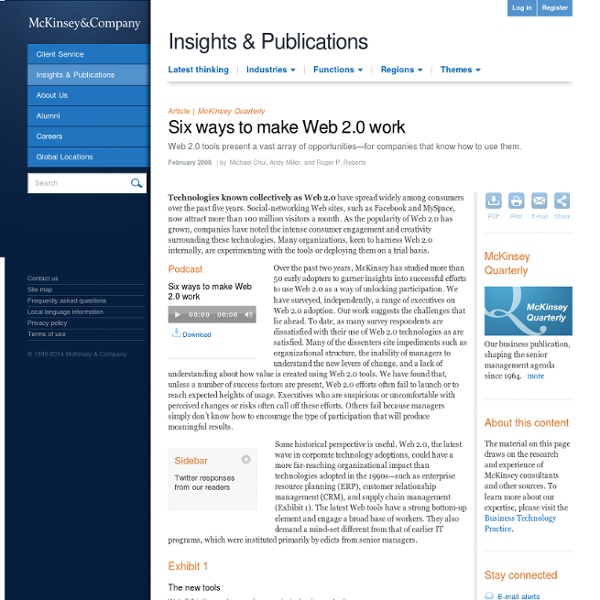Networking: Confessions of a Twitter Convert
I'm eating a hearty meal of crow (roasted, with garlic and rosemary) today, since I'm here to tell you how interesting and downright useful I've found Twitter to be since being turned onto it properly at the C4 conference in August. My initial reaction to Twitter was that it was utterly inane, but I was basing my opinion on the public timeline that shows posts from all Twitter users and on the Twittervision service that plots messages from Twitter users on a map of the world (see "Visions of the Sublime and the Inane," 2007-06-18). Frankly, I put much of the blame on Twitter itself, asking as it does, "What are you doing?" as a way of prompting people to post 140-character messages. For the most part, as I acerbically noted before, no one cares what you're doing. However, that's not entirely true, and what I missed in my quick and disdainful overview is that a certain number of people do care what you're doing, as long as it's interesting, funny, or relevant in some other way.
Jonas Brothers: Tweet us your questions for a live video chat...
Anyway : Twitter Musings
Tim recently posted about Twitter, and it got me thinking I should blog some of my own thoughts on the subject of Twitter (and related services such as Jaiku). Tim’s not the only person to move from tweeting a balanced mix that includes apparently superficial trivia to mainly, or even only, tweeting work or business-related stuff. From my point of view, that’s regrettable. I follow only a few people, mostly people I know in person, because I want to know what they’re up to and maintain some sort of contact with them as people, not because I see them as sources of business information. I’ve watched people’s blogs go from personal-with-some-work to mostly-work, now I’m watching people’s twitter feeds go through the same transformation, and for me there’s a feeling of loss, a feeling that I’m just watching more masks (thinking back to Julie Leung’s talk at Northern Voice) being put in place.
Twitscoop - Stay on top of twitter! - Search twitter, twitter client, hot trends
Homepage | Zigtag
OneRiot.com - Find the Pulse of the Web
A few weeks ago, a small team from @WalmartLabs visited the offices of OneRiot in beautiful Boulder, Colorado. OneRiot has developed some pretty nifty technology that analyzes social media signals from popular networks like Twitter and Facebook to deliver ads that are relevant to consumers’ interests. As our teams debated the finer points of Big Data, Fast Data, and machine learning technologies, it became clear to us that we could find no better colleagues than the guys at OneRiot. As a part of Walmart, we're continuing to work with the intensity of a technology startup. As I have written before, here at @WalmartLabs we’re doing some amazingly interesting and impactful work at the intersection of social, mobile, and retail. It gives me great pleasure to welcome Tobias Peggs and the OneRiot team to @WalmartLabs!
Superlist of What NOT To Do In Social Media (UPDATED)
Are you using content marketing as part of your digital strategy to grow your business? If so, you're not alone. According to the Content Marketing Institute, the lion's share of marketers (some 92%) report using content marketing. In the fast moving world of digital strategy, things are always changing. What should you expect in 2014 to change in the world of content marketing? Hana Abaza of Uberflip has put together an infographic detailing five key content marekting trends for the coming year. 1. 2. 3. 4. 5.
Search Engine Optimization | Learn How To Make Money Online at The Keyword Academy
Search engine optimization (SEO) is the art and science of improving your traffic from search engines – particularly (but not exclusively) from Google. Most SEO experts will focus primarily on Google because it is by far the largest search engine in the world, but will also try to improve traffic from Yahoo, MSN/Live, and Ask.com because they are still getting significant amounts of users each day. Google accounts for 72.70% of all searches in the United States, according to Hitwise: Google accounts for 62.9% of all searches in the United States, according to comScore: As you can see, there is a huge gap between Google and everyone else.That gap gets bigger every day. Focusing your efforts on Google will give you the most traffic and that’s why Google optimization and search engine optimization are becoming more and more synonymous. Search Engine Positioning and Traffic Potential You can use the Google Adwords Keyword Tool to find out how many times each phrase is searched for.
IntenseDebate
Informative and Usable Footers in Web Design
Advertisement Website designs have so many different elements that work together to convey information in a usable and organized manner. For a website to be effective, every element on the page, from the header to the footer, needs to add to its overall usability and readability. In this article, we’ll take a look at the footer and see what exactly makes for a good website footer. Keep in mind that just because the footer is at the bottom of the page doesn’t mean you should slack off with good design practice. We’ll look here at what to include in footers, the importance of site maps, usability practices and styling ideas and trends. What To Include In Footers Before we go over how exactly to design the footer, let’s talk about common elements to include in footers and the importance of each. Site Map Usability is foremost in importance in Web design. In the site map below, visited pages show up differently than the other links. Quick “About” or “Contact” Information A Simple Contact Form



